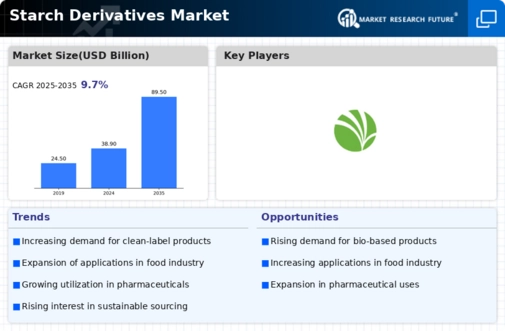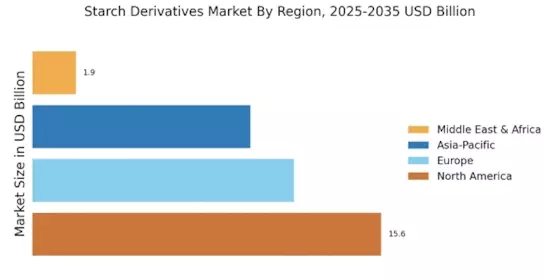Growth in Personal Care and Cosmetics
The Starch Derivatives Market is experiencing growth in the personal care and cosmetics sector, where starch derivatives are utilized for their thickening and stabilizing properties. Ingredients such as modified starches are increasingly incorporated into formulations for lotions, creams, and powders, enhancing product texture and performance. The personal care segment is projected to witness a growth rate of around 4% in the coming years, driven by consumer demand for high-quality and effective cosmetic products. As brands strive to differentiate themselves in a competitive market, the incorporation of starch derivatives is likely to play a crucial role in product development and innovation.
Increasing Application in Food Industry
The Starch Derivatives Market is experiencing a notable surge in demand due to the increasing application of starch derivatives in the food sector. Starch derivatives, such as maltodextrin and modified starches, are widely utilized as thickening agents, stabilizers, and emulsifiers in various food products. This trend is driven by consumer preferences for texture and mouthfeel, which are essential in processed foods. According to recent data, the food segment accounts for a substantial share of the starch derivatives market, with projections indicating a growth rate of approximately 5% annually. As manufacturers seek to enhance product quality and meet consumer expectations, the reliance on starch derivatives is likely to continue, thereby bolstering the overall market growth.
Expansion in Pharmaceutical Applications
The Starch Derivatives Market is witnessing an expansion in its applications within the pharmaceutical sector. Starch derivatives are increasingly employed as excipients in drug formulations, serving as binders, disintegrants, and fillers. This trend is largely attributed to the growing demand for oral solid dosage forms, which require effective and reliable excipients to ensure drug efficacy. Recent statistics suggest that the pharmaceutical segment is projected to grow at a compound annual growth rate of around 6% over the next few years. As pharmaceutical companies prioritize the development of innovative drug delivery systems, the role of starch derivatives is expected to become more pronounced, thereby driving market growth.
Rising Demand for Biodegradable Products
The Starch Derivatives Market is significantly influenced by the rising demand for biodegradable products. As environmental concerns gain prominence, industries are increasingly seeking sustainable alternatives to synthetic materials. Starch derivatives, being derived from renewable resources, offer a viable solution for producing biodegradable plastics and packaging materials. Recent market analyses indicate that the biodegradable segment is expected to grow at a rate of approximately 7% annually, reflecting a shift towards eco-friendly solutions. This trend not only aligns with consumer preferences for sustainable products but also encourages manufacturers to innovate and expand their offerings in the starch derivatives market.
Technological Innovations in Processing Techniques
The Starch Derivatives Market is benefiting from technological innovations in processing techniques, which enhance the efficiency and quality of starch derivative production. Advances in enzymatic processing and modification methods allow for the creation of tailored starch derivatives that meet specific industry requirements. This is particularly relevant in sectors such as food and pharmaceuticals, where precision and consistency are paramount. Recent developments suggest that the adoption of these innovative processing techniques could lead to a reduction in production costs by up to 15%, thereby making starch derivatives more accessible to manufacturers. As technology continues to evolve, the market is likely to see an influx of new products and applications, further driving growth.


















Leave a Comment